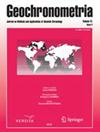以树木年代学为基础绘制滑坡灾害图——以波兰喀尔巴阡山脉西部为例
IF 0.9
4区 地球科学
Q3 Earth and Planetary Sciences
引用次数: 13
摘要
摘要大多数滑坡灾害地图是根据一个地区对滑坡发生的易感性绘制的,但树状时间技术允许人们根据过去的滑坡活动绘制地图。这项研究的目的是使用树状时间技术开发一张覆盖3.75平方公里的大面积滑坡灾害地图。我们收集了生长在46个采样点的131棵树的岩芯,测量了树木年轮宽度,并确定了生长偏心率事件(当树干两侧形成不同宽度的树木年轮时发生)的年代,记录了过去几十年中发生的滑坡事件。然后,计算每个采样点每十年发生的滑坡事件的数量。我们对获得的值进行了插值,添加了房屋和道路图层,并绘制了滑坡危险地图。该地图突出显示了对现有建筑、道路和未来发展可能安全的区域。基于树状时序数据开发的滑坡灾害地图的主要优点是可以以相对较低的成本获取大面积滑坡活动的长系列数据。主要缺点是,所获得的结果与倾斜树木木材中发生的环状结构的解剖变化和宏观特征的测量有关,而这些因素仅提供了有关滑坡事件发生时间的间接信息。本文章由计算机程序翻译,如有差异,请以英文原文为准。
Dendrochronological dating as the basis for developing a landslide hazard map – An example from the Western Carpathians, Poland
Abstract Most landslide hazard maps are developed on the basis of an area’s susceptibility to a landslide occurrence, but dendrochronological techniques allows one to develop maps based on past landslide activity. The aim of the study was to use dendrochronological techniques to develop a landslide hazard map for a large area, covering 3.75 km2. We collected cores from 131 trees growing on 46 sampling sites, measured tree-ring width, and dated growth eccentricity events (which occur when tree rings of different widths are formed on opposite sides of a trunk), recording the landslide events which had occurred over the previous several dozen years. Then, the number of landslide events per decade was calculated at every sampling site. We interpolated the values obtained, added layers with houses and roads, and developed a landslide hazard map. The map highlights areas which are potentially safe for existing buildings, roads and future development. The main advantage of a landslide hazard map developed on the basis of dendrochronological data is the possibility of acquiring long series of data on landslide activity over large areas at a relatively low cost. The main disadvantage is that the results obtained relate to the measurement of anatomical changes and the macroscopic characteristics of the ring structure occurring in the wood of tilted trees, and these factors merely provide indirect information about the time of the landslide event occurrence.
求助全文
通过发布文献求助,成功后即可免费获取论文全文。
去求助
来源期刊

Geochronometria
地学-地球科学综合
CiteScore
2.20
自引率
0.00%
发文量
1
审稿时长
>12 weeks
期刊介绍:
Geochronometria is aimed at integrating scientists developing different methods of absolute chronology and using them in different fields of earth and other natural sciences and archaeology. The methods in use are e.g. radiocarbon, stable isotopes, isotopes of natural decay series, optically stimulated luminescence, thermoluminescence, EPR/ESR, dendrochronology, varve chronology. The journal publishes papers that are devoted to developing the dating methods as well as studies concentrating on their applications in geology, palaeoclimatology, palaeobiology, palaeohydrology, geocgraphy and archaeology etc.
 求助内容:
求助内容: 应助结果提醒方式:
应助结果提醒方式:


